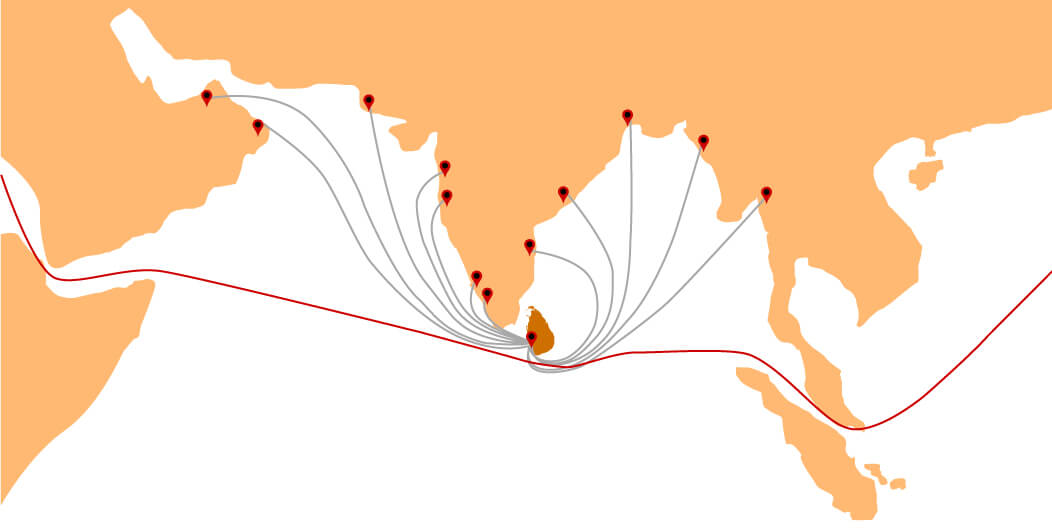Sri Lanka’s strategic location among the main marine and air navigation routes within the South Asian region makes the country a lucrative destination for entrepot and logistic development.
The country’s close proximity to emerging markets, and it’s already developed air and seaports in Colombo and Hambantota makes it an important logistics hub in the region providing entrepot and transhipment services to leading shipping lines and exporters.
During the last five years, the World Shipping Council has consecutively ranked Sri Lanka’s Colombo Port among Top 50 World Container Ports above other South Asia ports based on the volume of the containers handled.
Sri Lankan logistics services contribute 2.5% of gross domestic product, which represents around USD 2 billion. Logistics services include container trucking, warehousing, ports and shipping, but exclude domestic transport of passengers, fisheries and interregional domestic cargo transportation.
The total share of logistics in national exports is estimated at 7%. The industry provides full-time direct employment to over 40,000–50,000 people. Around 70% of registered service providers are of local origin while the rest are multinational. Currently, there are 130 shipping agencies and 120 freight forwarders in associations, and 500+ companies registered with the Merchant Shipping Secretariat (MSS), which also includes clearing agents.
In addition to the expansion of its seaports, the country also has the highest road density in South Asia, with 173.9 km of roads per 100 square km of land, connecting all major seaports and airports. The country also has 22 international and domestic airports, with five international airports situated in Batticaloa, Colombo, Hambantota, and Jaffna.
In its ambitious plan for the future, the country is aiming at becoming a multimodal logistics hub providing integrated services and facilities by developing physical, telecommunication, and information technology infrastructure between the air and seaport facilities in Sri Lanka.

For the last ten years, the Port of Colombo reported a steady growth of 4.5% in container traffic and transhipment volume accounted for more than 75% of the total container quantity.
There are three types of trans-shipment methods practised in Sri Lanka:
Sri Lanka is the main transhipment hub for the Indian subcontinent, mainly to Indian Peninsular and other South Asian Countries, mainly to take the best advantage out of the free trade agreements between South Asian countries (SAFTA), Sri Lanka and Singapore, and the country’s participation in the Generalized System of Preferences (GSP).
Colombo Port focuses on container trans-shipment largely for the textile industry while Magampura International Port in Hambantota provides services mainly for vehicle transhipment (roll-on/roll-off operations). Japanese, Korean and Indian carmakers use this port for trans-shipping vehicles built in India, Thailand, Japan and China to markets in Africa, the Middle East, Europe and the Americas.
Entrepót trade or the re-export trade involves importing goods from one country and re-exporting to another, with or without any additional processing or repackaging. Goods are exempt from duties at the point of import and re-exports.
With the introduction of the commercial hub regulations through amendments made to the Finance Act No 12 of 2012 of Sri Lanka in the year 2013, a wide range of possibilities for entrepot trade in Sri Lanka, namely;
Governed by these regulations Sri Lanka will allow cargo transfers between ships and aircraft without the need to actually send the goods through a bonding warehouse. The country has designated free ports and bonded areas including Colombo Port, Hambantota Port, Mattala Airport, Katunayake EPZ, Koggala EPZ, Mirijjawila EPZ, and Colombo Airport Cargo Terminal to carry out entrepot trade.
The Indian Ocean is an emerging growth pole and one of the busiest East-West trade corridors. Over ⅔ of global oil shipments and ⅓ of bulk cargo are transported through the Indian Ocean while ⅓ of the global bulk shipping trade, including petroleum products and coal transit across this region are transported through the Indian Ocean.
Positioned between the two leading logistic hubs in Singapore and Dubai, Sri Lanka handles over 25% of the regional container throughput, which makes the development and expansion of commercial logistic hubs an obvious future to the Sri Lankan logistic sector.
Establishment of commercial logistic hubs, which are specific area designated to deal with activities related to transportation, organization, separation, coordination and distribution of goods for national and international transit, on a commercial basis by various operators within a network of logistic parks has been the priority of Sri Lanka.
The country also facilitates cargo consolidation, multi-country consolidation and other ancillary services to meet global requirements.
With a view to reducing costs and increasing the efficiency of shipments, Sri Lanka has liberalised multi-country consolidation (MCC) and has ambitious plans to develop a logistic distribution centre in the South Harbour in collaboration with the China Merchants (CM) Port. The o projects will focus on the needs of the MCC operators who prefer to receive space within the port itself. A new pilot project also focuses on implementing a Warehouse Management System (WMS) and improving the cargo management system, in order to provide electronic payment and delivery facilities.
Sri Lanka’s growing reputation as a marine engineering hub in the South Asian region and our growing capacity in offshore engineering has also added to the country’s reputation as an emerging logistics hub providing a complete suite of logistic services.
At present, Sri Lanka provides other auxiliary maintenance and replenishing services including dry and wet dock repairs, crew changes, supplying and replenishing victuals and water. Apart from Sri Lanka’s reputation as a low-cost supply base and the recently introduced special tariff reductions for transhipment facilities, the country also offers unique aspects in relation to its position and size.
Sri Lanka practices a variety of trans-shipment methods including Hub-and-Spoke, Interlining/ Intersection, and Relay. Sri Lanka also provides auxiliary maintenance and replenishing services including dry and wet dock repairs, crew changes, supplying and replenishing victuals and water.